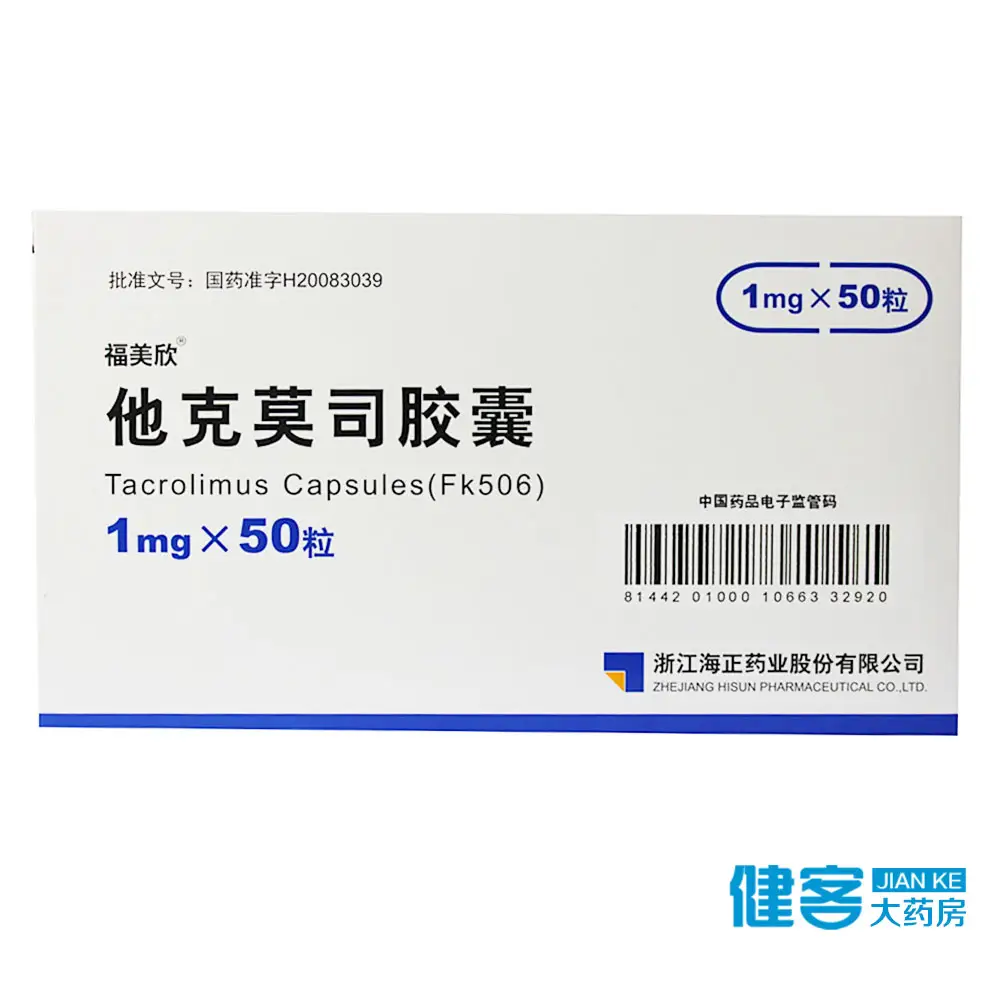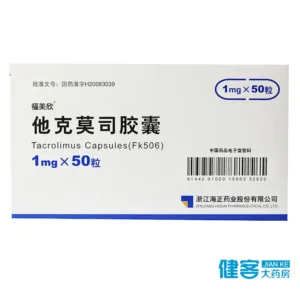Tacrolimus
Effects and efficacy:
Used to prevent rejection after transplantation, including bone marrow transplantation and solid organ transplantation (such as liver, kidney, heart, etc.). Used as a second-line treatment for moderate to severe atopic dermatitis (ointment). For spring conjunctivitis with ineffective anti-allergic treatment, it should be used when giant papillae of the eyelid conjunctiva are observed to proliferate (eye drops).
Usage and dosage:
When used in combination with azathioprine for kidney transplantation, 0.2 mg/Kg per day, taken twice, once every 12 hours, and the dose is adjusted according to the blood drug concentration. The trough concentration is 7-20 ng/mL in the first to third months after transplantation, and the trough concentration is 5-15 ng/mL in the fourth to twelfth months; when used in combination with mycophenolate mofetil or IL-2 receptor antagonist, 0.1 mg/Kg per day, taken twice, once every 12 hours, and the dose is adjusted according to the blood drug concentration. The trough concentration is 4-11 ng/mL in the first to twelfth month after transplantation. Liver transplantation is only combined with glucocorticoids, 0.1~0.15mg/Kg per day, taken twice, once every 12 hours, the dose is adjusted according to the blood concentration, and the trough concentration is 5~20ng/mL in the first to 12 months after transplantation. Heart transplantation is combined with azathioprine or mycophenolate mofetil, 0.075mg/Kg per day, taken twice, once every 12 hours, the dose is adjusted according to the blood concentration, the trough concentration is 10~20ng/mL in the first to third months after transplantation, and the trough concentration is 5~15ng/mL after 4 months. Children’s kidney transplantation is 0.3mg/Kg per day, taken twice, once every 12 hours, the dose is adjusted according to the blood concentration, and the trough concentration is 5~20ng/mL in the first to 12 months after transplantation. The capsule for liver transplantation in children is 0.15~0.2mg/Kg per day, and the oral suspension is 0.2mg/Kg per day, taken twice, once every 12 hours, and the dose is adjusted according to the blood concentration. The trough concentration is 5~20ng/mL in the first to 12 months after transplantation. The capsule for liver transplantation in children is 0.15~0.2mg/Kg per day, and the oral suspension is 0.2mg/Kg per day, taken twice, once every 12 hours, and the dose is adjusted according to the blood concentration. The trough concentration is 5~20ng/mL in the first to 12 months after transplantation. The capsule for liver transplantation in children is 0.15~0.2mg/Kg per day, taken twice, once every 12 hours, and the dose is adjusted according to the blood concentration. The trough concentration is 5~20ng/mL in the first to 12 months after transplantation. The capsule for lung transplantation is 0.05~0.7mg/Kg per day, taken twice, continuously intravenously, and the target trough concentration is 8~13ng/mL. If the patient can tolerate it, sequential infusion is performed as soon as possible until oral administration. Bone marrow transplantation is combined with methotrexate, taken twice, once every 12 hours, and the target trough concentration is 10~20ng/mL. Myasthenia gravis is 3mg per day, taken twice, once every 12 hours, and the dose is adjusted according to the blood concentration. The trough concentration is 4~10ng/mL. Nephrotic syndrome: 0.05~0.1mg/kg per day, taken twice, once every 12 hours, and the dose is adjusted according to the blood concentration. The dose is adjusted to the target trough concentration of 5~10ng/mL in the first 6 months, 4~6ng/mL in the next 3 months, and then gradually reduced, and discontinued after 12 months. Membranous glomerulonephritis: 0.05~0.1mg/kg per day, taken twice, once every 12 hours, and the dose is adjusted to maintain the blood concentration of 2~10ng/mL, or 1mg/d orally, and the dose is adjusted to maintain the blood concentration of 2~4ng/mL, for 6~12 months. Autoimmune diseases: Take once a day or twice, the trough concentration does not exceed 20ng/mL, the specific dosage and trough concentration range depend on the severity and activity of the disease.
Adverse reactions:
Gastrointestinal reactions: such as constipation, diarrhea, nausea, and vomiting. In severe cases, digestive tract perforation can be seen. Cardiovascular system: peripheral edema, prolonged QT interval, and hypertension. In severe cases, atrial fibrillation, cardiac arrest, cardiac hypertrophy, congestive heart failure, and myocardial infarction may occur. Skin: common hair loss, skin erythema, itching, and rash. Blood system: common anemia, leukocytosis, and thrombocytopenia. Rare pure red cell aplasia. Nervous system: common headaches, insomnia, paresthesias, and tremors. Rare epilepsy and reversible posterior encephalopathy syndrome. Occasionally, liver and kidney function abnormalities are seen. Rare acute respiratory distress syndrome. If the above adverse reactions occur, please inform your doctor or pharmacist in time. Once an adverse reaction (side effect) occurs, the drug should be stopped immediately and the doctor should be notified so that the doctor can judge the severity of the adverse reaction and take necessary measures.
Drug contraindications:
This product is contraindicated if you are allergic to it.
Share:
Products
Our offers
Health Classification
Let us work together to protect precious health






























